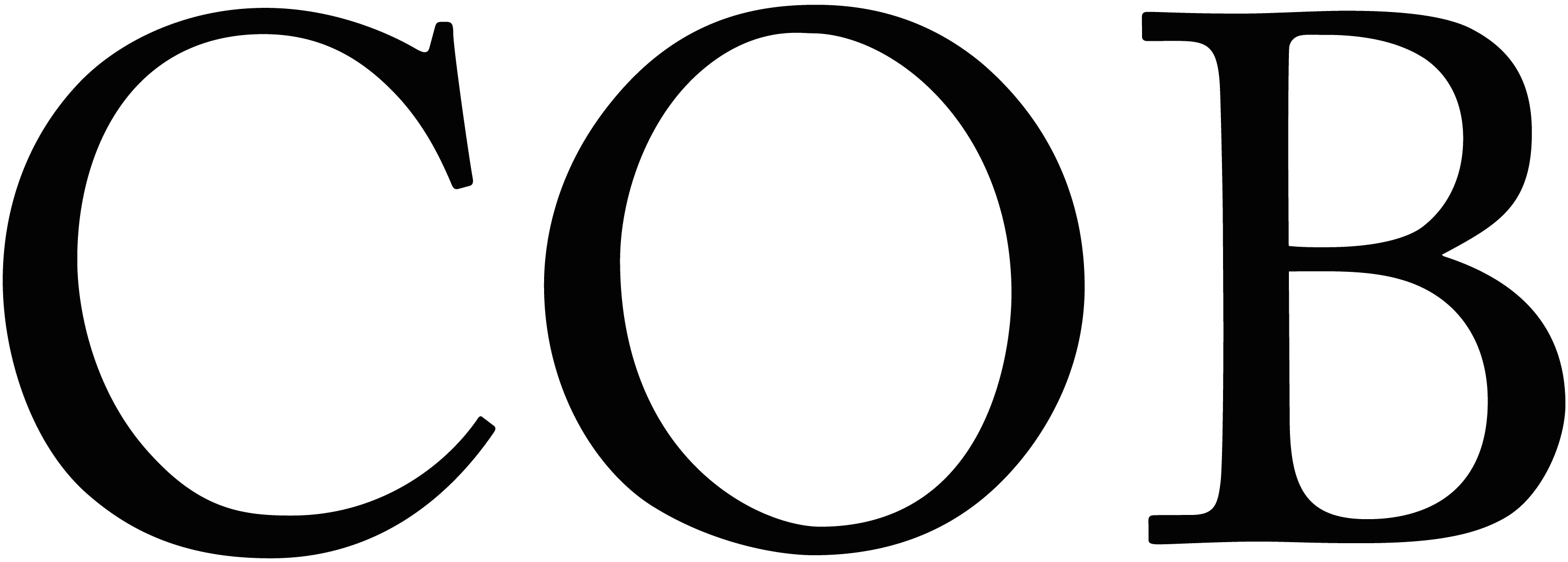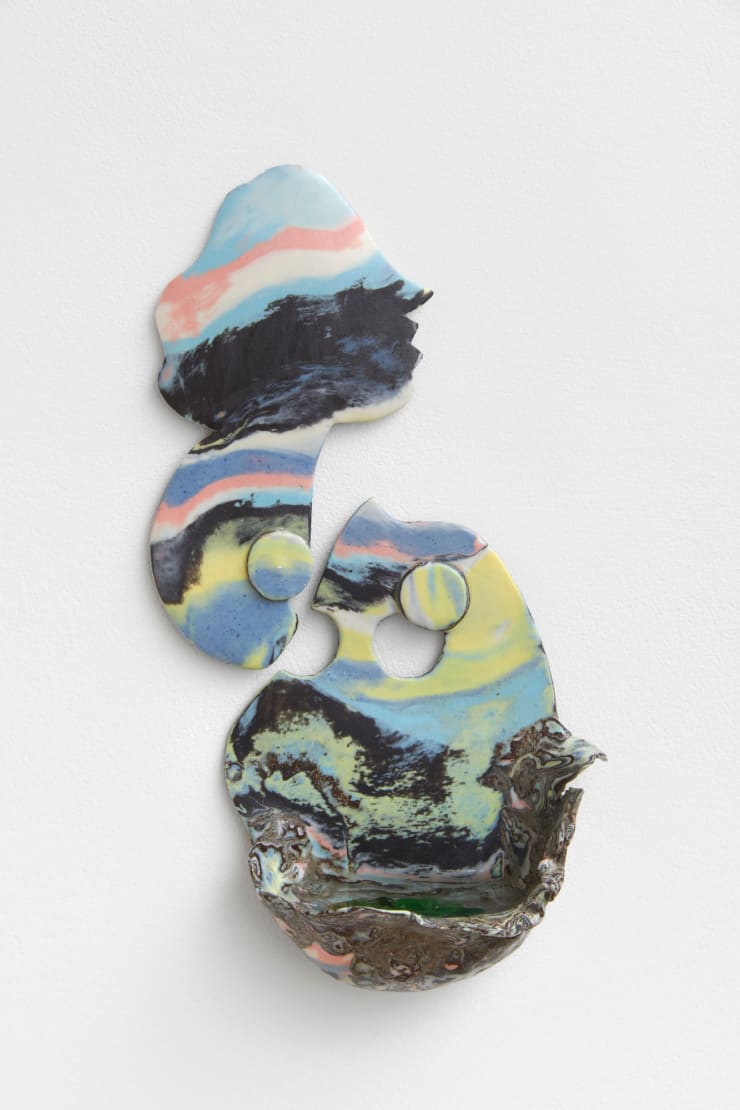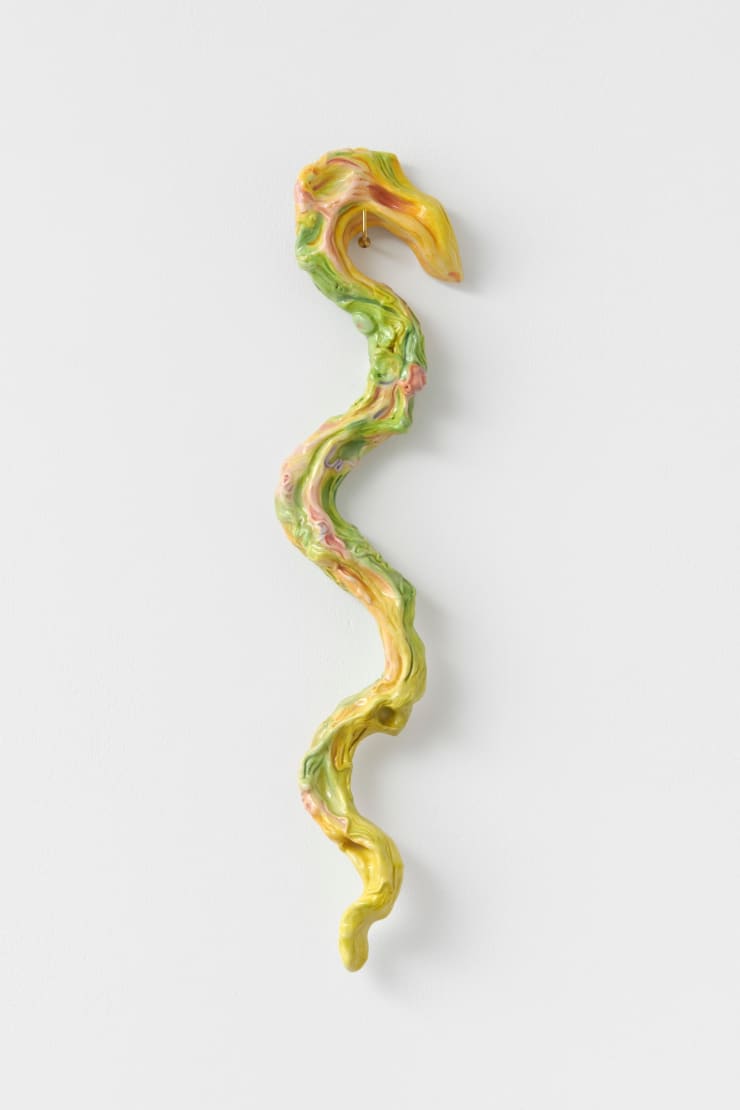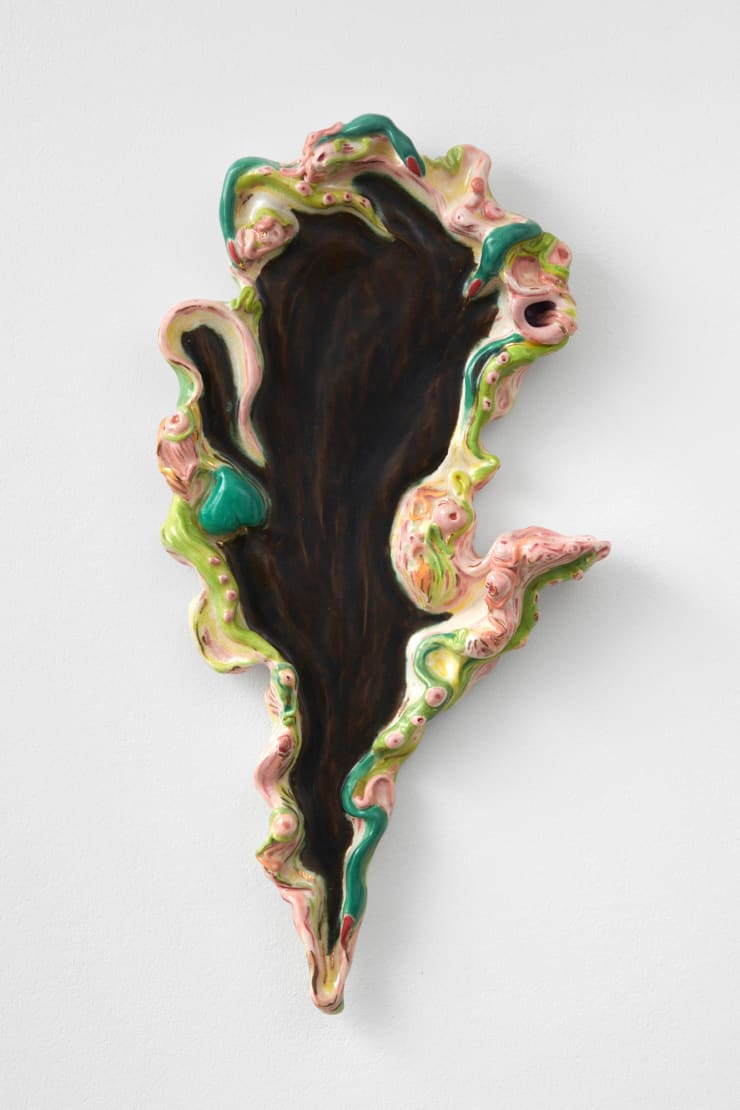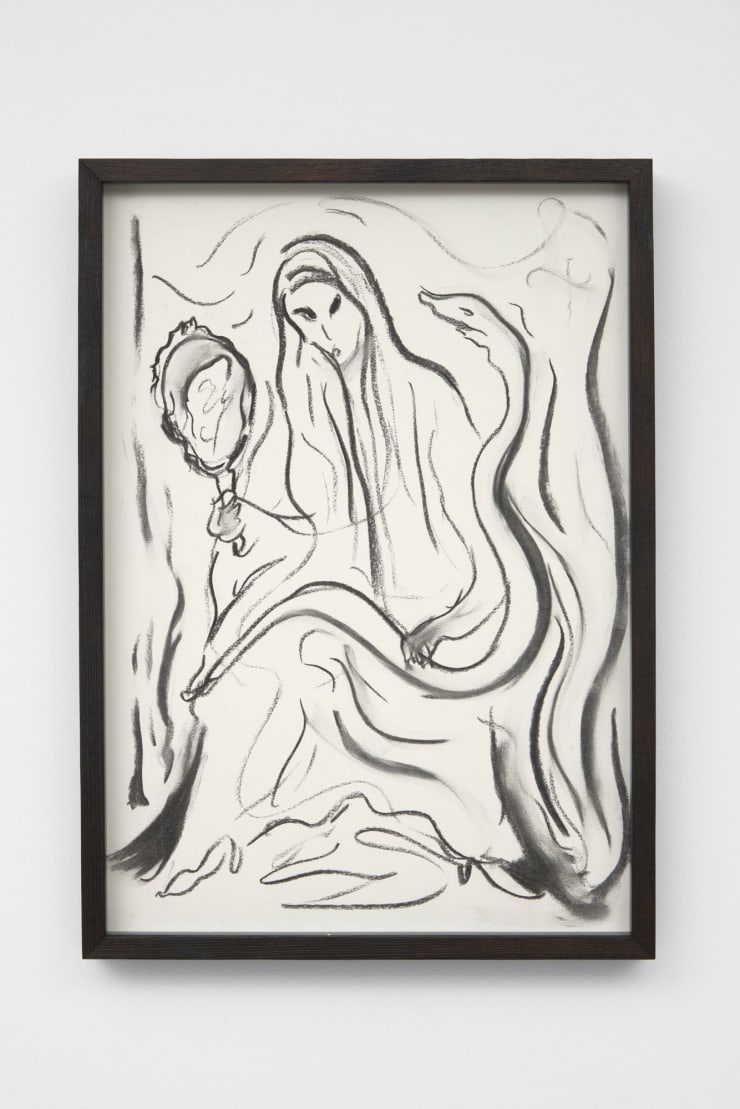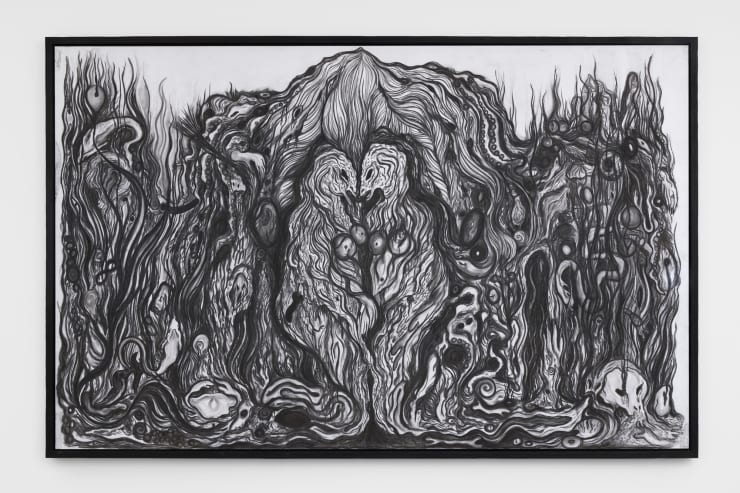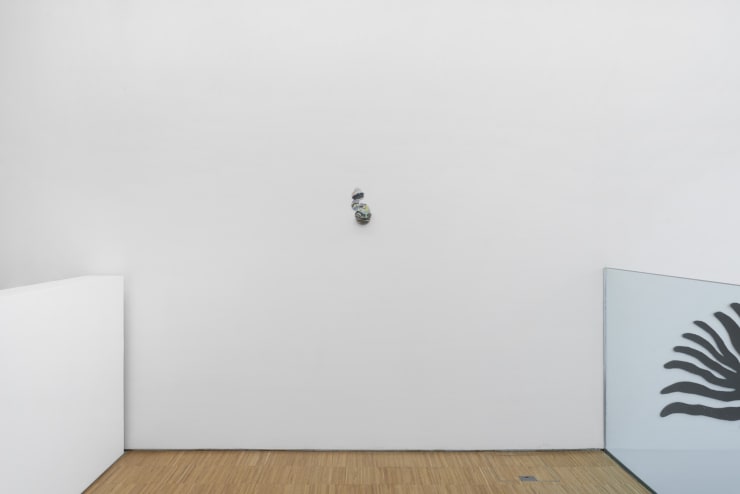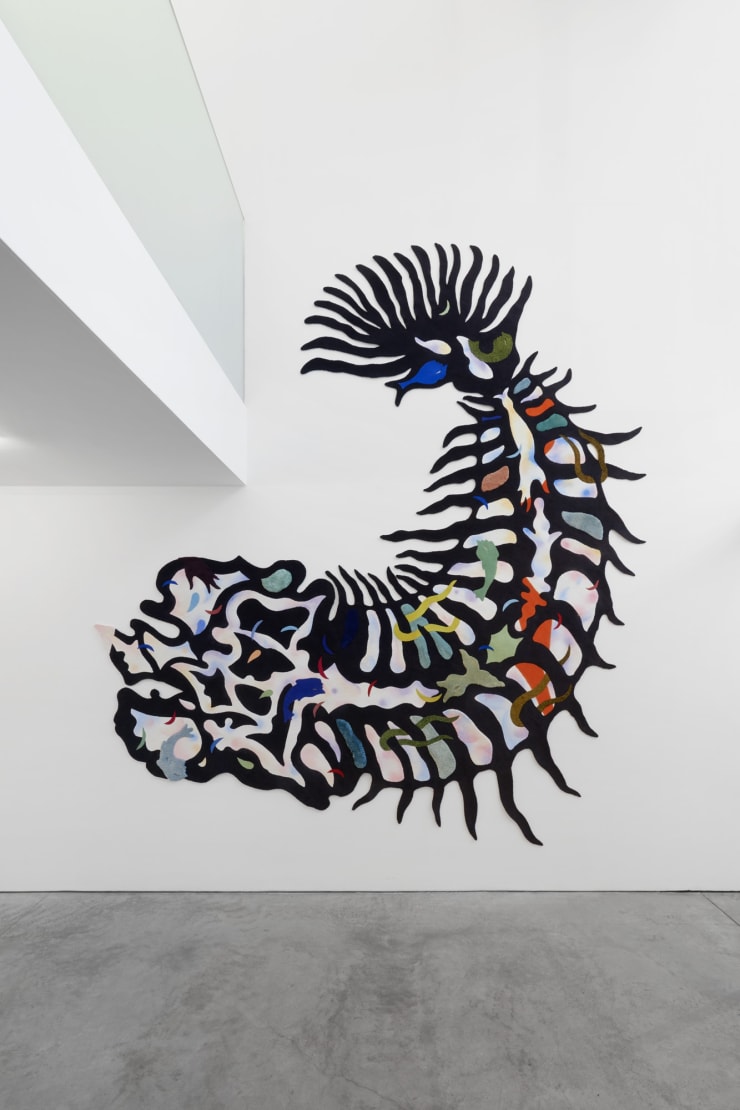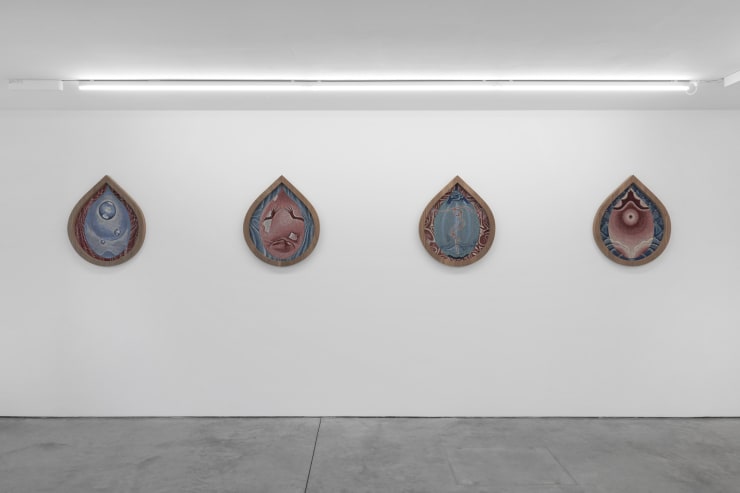Psychic Anemone: Group Exhibition
Bea Bonafini | Charlotte Edey | Zoe Williams
Cob Gallery is proud to present Psychic Anemone, a group exhibition of mixed-media work by Bea Bonafini, Charlotte Edey and Zoe Williams that brings together ceramic sculpture, painting, large-scale tapestry and charcoal drawings and marks the completion of the gallery’s ten-year anniversary programme, which has focused on female-identifying artists.
These artists are brought to comparison for their multilayered artistic approaches to the transcendental image. Through their powerfully individual languages of symbolism Bonafini, Edey and Williams address similar themes which include the body politic, ritual, magic, gender, mythology, spirituality, eroticism and sensuality.
The works in Psychic Anemone are anchored to a liquidity of form and as such, can be explored through an implication of ‘hydrofeminism’ – a mode of posthuman feminist phenomenology that understands our bodies as fundamentally a part of the natural world, not separate from it or bearing any privileged relation to it.
As the term itself suggests, the cultural association of women with water is a key area of critical and aesthetic interest. Water imagery, and symbolism relating to feminine subjectivity and embodiment, pervade the works on display, and the exhibition takes its name from the protagonist of British artist Tai Shani’s text Our Fatal Magic: twelve fantastical prose pieces that fuse together horror, sci-fi and other pulp genres to propose a post-patriarchal future, cultivating an eroticised and often violent space of critique in which gender constructs are destabilised within a setting overloaded by water and liquid imagery.
In the western tradition, both water and women have been traditionally associated with birth and re-birth, creation and creativity, but also with purification and poison, death and oblivion. Water transforms, and it can cause transformation in other objects; it twists and turns and changes direction; it freezes to a solid or boils to a gas. In classical myth, such as Ovid’s Metamorphoses, water is frequently the site of change: Hermaphroditus enters the water and is bonded forever with his female pursuer, becoming both male and female; Cyane, in her grief, actually dissolves into water. In the medieval period, water and women were perceived as equally changeable: in much medieval literature, women are portrayed as inconstant or unfaithful. Medieval medicine, meanwhile, held that every human body was made up of four humours – yellow bile, black bile, phlegm and blood – each with its own elemental counterpart: fire, earth, water and air. Men and women were partly differentiated in terms of the way these elements were balanced: men were thought to be hot and dry, associated with fire and an excess of yellow bile; women were believed to be more watery and therefore more phlegmatic. These ideas took a more sinister turn in the late Middle Ages with the emergence of ‘swimming tests’ – a form of torture used to unmask witches. Here classical pseudoscience was fused with Christian belief: since witches were believed to have spurned the sacrament of baptism, it was thought that the water would reject their body and cause them to bob on the surface, whereas an innocent person would sink like a stone.
We are all bodies of water, and yet to think of embodiment as watery belies the understanding that we have inherited from the dominant Western metaphysical tradition of bodies as discrete, detached entities. As watery, we experience ourselves less as isolated beings, and more as oceanic eddies: singular, dynamic whorls dissolving in a complex, fluid circulation. The space between ourselves and others is at once as distant as the primeval sea, yet also closer than our own skin – the traces of those same oceanic beginnings still cycling through us, just pausing as this current bodily thing. Water is between bodies, and of bodies, before us and beyond us, but also very presently this body, too. This watery gestationality is also decidedly posthuman, where human wombs are but one expression of a more general aqueous facilitative capacity: pond life, sea monkey, primordial soup, amphibious egg, the moist soil that holds and grows the seed. As Charles Darwin once quipped: ‘Our ancestor was an animal which breathed water, had a swim bladder, a great swimming tail, an imperfect skull, and was undoubtedly a hermaphrodite!’ Darwin’s ‘pleasant genealogy’ reminds us of our fishy evolutionary beginnings, with all terrestrial life ultimately coming from the sea and folding that marine habitat inside itself as it learned to stand on its own two feet. The story also reminds us that all watery bodies are ‘carrier bags’, to use feminist sci-fi writer Ursula K. Le Guin’s term. She suggested that the first tool that humans took up was not a sharp pointy weapon but rather a carrier bag: a net, a basket, a bottle, a sling.
This different kind of hydrological cycle insists that we relinquish any lingering illusion of nature as separate from culture, or of humans as separate from or superior to the world around us. As such, we are not on the one hand embodied (with all the cultural and metaphysical investments of this concept) while on the other hand primarily comprised of water (with all the attendant biological, chemical, and ecological implications). We are both of these things, inextricably and at once – made mostly of wet matter. We live at the site of exponential material meaning where embodiment meets water. Given the various interconnected and anthropogenically exacerbated water crises that our planet currently faces – from drought and freshwater shortage to wild weather, floods, and chronic contamination – this meaningful mattering of our bodies is also an urgent question of worldly survival.
Bea Bonafini
Bea Bonafini’s interdisciplinary practice draws from oneiric visions, overlapping personal and ancient mythologies. Her tactile, intimate worlds centre around sensuality, vulnerability and fantasy, forming swirling scenarios that are fragmented and multi-layered. Figures are evanescent and transcendental, referencing spiritual imagery where fluid bodies collide, disperse, swim, fly and fall. The focus on universal human experiences – birth, death, illness, love - unfolds and proliferates ambiguously, simultaneously graspable and fleeting.
Bonafini’s work expands the possibilities and interplay of painting, tapestry and sculpture. Holistic perspectives are developed in close dialogue with architecture, where works are expanded in space to envelop the viewer. Acting as protected spheres, Bonafini’s installations act as openings onto encounters between the earthly and the otherworldly.
Face of the Deep I is Bonafini’s most recent carpet work as featured in Psychic Anemone. Bonafini uses the clippings of fabrics as if they were strokes of colour, ready to create shapes that are at once abstract and figurative, a familiarity whose meaning escapes us when we think we have caught it. The work shares its title with a groundbraking book in postmodern feminist theology by Catherine Keller, who reinterprets the cosmic creative process to incorporate creation myths, chaos, the sexual and the mystical. Bonafini’s tapestry attempts to put a face to the deepest depths of the oceans that personifies our subconscious: the skeleton of a prehistoric fish crushed by the infinite pressure of the ocean floor. Such monsters animate the primodial waters that perhaps we all came from. The hybridity of this hand-cut, inlayed textile piece lies between tapestries and carpets, inviting the viewer to caress its tender flesh, powdered with pastels.
Charlotte Edey
Charlotte Edey’s work is primarily concerned with contemporary issues of selfhood and the politics of space. Her narratives employ cultural signifiers to allow personal mythologies to weave life into ancient motifs through the language of symbolism.
Her process combines tapestry, embroidery and sculptural walnut as an expansion of her drawing practice. This journey between dimensions from her works on paper - what is added, altered and even removed by these multiple processes - creates a complex layering to her textile work. Mark-making and gesture are explored through hand-embroidery in silk, forging a relationship between drawn line and thread. Her installations reference ritualistic methods of display from altarpieces to shrines, forming portals to imagined other- worlds that offer the opportunity to investigate our present.
Psychic Anemone features a new series of four embroidered tapestries. The works draw upon the idea of the ‘bottle’ or container as hero, as detailed in The Carrier Bag Theory of Fiction by Ursula K Le Guin. In the essay, Le Guin presents a theory of human evolution drawn from Elizabeth Fisher’s cult feminist text Woman’s Creation: Sexual Evolution and the Shaping of Society that the first human tool was not a weapon but a receptacle, something that made it possible to collect more than could be held in the hands. Taking the form of a teardrop, the works foreground the experience of the body as vessel through collected fragments; hands, hair, the mouth, and the eye.
The textile works are accompanied by soft pastel drawings that consider this role of container. Without the contours of the bottle to define and hold the form, the essence is fluid and malleable; yet to be constrained by a preordained shape. The drawings forge a connection between both the origin state of the bottled essence and the drawings the tapestries themselves are formed from.
Zoe Williams
Zoe Williams' practice incorporates a range of mediums including moving image, ceramics, drawing and performance and is often collaborative in its process and outcome. These elements are combined to create immersive objects and environments, which conjure a playful and corrosive interchange between notions of the erotic, craft, magic, gender, hedonism and excess. Through the cross contamination of these influences, she wishes to provoke conversations around the pressures of power, the politics of sex and the economics of production. Her work explores the shifting use values of objects and rituals through history and within contemporary society.
Psychic Anemone features a suite of charcoal drawings and new ceramic sculptures created by the artist on residency in southwest Cornwall in early 2021. For this body of work, the artist sought to explore how humans imprint fears and desires onto a landscape, as such, these drawings emerge as an emotional, spiritual and conceptual response to the local traditions, conditions and mythologies tied to the wild Cornish coast.
Immersing herself in the environment, the works are cross contaminated response to the region’s rich esoteric and Celtic history, Cornwall’s deep-rooted connections to paganism, magic and witchcraft and the theories and mysteries surrounding local ancient sites including mines, holy wells and holed stones. Travelling to these sites regularly, Williams ties her response to an interest in Earth Mysteries theories - the quasi-religious-come-pseudoscientific idea that focusses on cultural and religious beliefs about the Earth. The concept of Earth mysteries seeks to blend ancient monuments and mythology towards an "idealised vision" of nature. Both the drawings and ceramics are united through a recurring serpent motif - a hypersexualised characterization by Williams inspired by both the Tremalia - a fictious Cornish serpent deity conjured by poet Peter Redgrove, and the concept of walking the Serpent Path - a belief that Cornish witches animate the land by harnessing the Serpentine force within it.
-
 Bea BonafiniAlchemical Siren, 2019Stained porcelain, black clay, sea glass and salted water20 x 10 cm
Bea BonafiniAlchemical Siren, 2019Stained porcelain, black clay, sea glass and salted water20 x 10 cm -
 Zoe Williams Fools Stick, 2020 Glazed ceramic 50 x 9.5 x 4.5
Zoe Williams Fools Stick, 2020 Glazed ceramic 50 x 9.5 x 4.5 -
 Bea Bonafini Face Of The Deep II, 2021 Pastel on nylon carpet inlay 300 x 250 cm
Bea Bonafini Face Of The Deep II, 2021 Pastel on nylon carpet inlay 300 x 250 cm -
 Charlotte EdeySpider Lashes, 2021Silk hand-embroidery and freshwater pearl on woven jacquard in walnut54 x 64 cm (framed)
Charlotte EdeySpider Lashes, 2021Silk hand-embroidery and freshwater pearl on woven jacquard in walnut54 x 64 cm (framed) -
 Charlotte EdeyPiercing These Seams, 2021Silk hand-embroidery on woven jacquard in walnut54 x 64 cm (framed)
Charlotte EdeyPiercing These Seams, 2021Silk hand-embroidery on woven jacquard in walnut54 x 64 cm (framed) -
 Charlotte EdeyIn Cold Water, Her Curls Became Liquid, 2021Silk hand-embroidery and freshwater pearl on woven jacquard in walnut54 x 64 cm (framed)
Charlotte EdeyIn Cold Water, Her Curls Became Liquid, 2021Silk hand-embroidery and freshwater pearl on woven jacquard in walnut54 x 64 cm (framed) -
 Charlotte EdeyVelveteen Gasp, 2021Silk hand-embroidered on woven jacquard in walnut54 x 64 cm (framed)
Charlotte EdeyVelveteen Gasp, 2021Silk hand-embroidered on woven jacquard in walnut54 x 64 cm (framed) -
 Zoe WilliamsGreen Fingers, 2019Glazed ceramic with metallic lustre46 x 23 x 5 cm
Zoe WilliamsGreen Fingers, 2019Glazed ceramic with metallic lustre46 x 23 x 5 cm -
 Zoe WilliamsLair of the White Worm, 2021Charcoal on paper, charred wood frame42 x 29.7 cm
Zoe WilliamsLair of the White Worm, 2021Charcoal on paper, charred wood frame42 x 29.7 cm -
 Zoe WilliamsDog Fish Lovers, 2020glazed ceramic with metallic lustre50 x 9.5 x 4.5
Zoe WilliamsDog Fish Lovers, 2020glazed ceramic with metallic lustre50 x 9.5 x 4.5 -
 Zoe WilliamsConjunction Magma (Splitting anxiety), 2021Charcoal on paper, charred wood frame150 x 250 cm
Zoe WilliamsConjunction Magma (Splitting anxiety), 2021Charcoal on paper, charred wood frame150 x 250 cm -
 Zoe WilliamsThe Golden Palm, 2021Glazed ceramic20 x 12 cm
Zoe WilliamsThe Golden Palm, 2021Glazed ceramic20 x 12 cm -
 Bea BonafiniTied, 2021gouache and carat d'ache on engraved cork25 x 25.5 cm
Bea BonafiniTied, 2021gouache and carat d'ache on engraved cork25 x 25.5 cm
